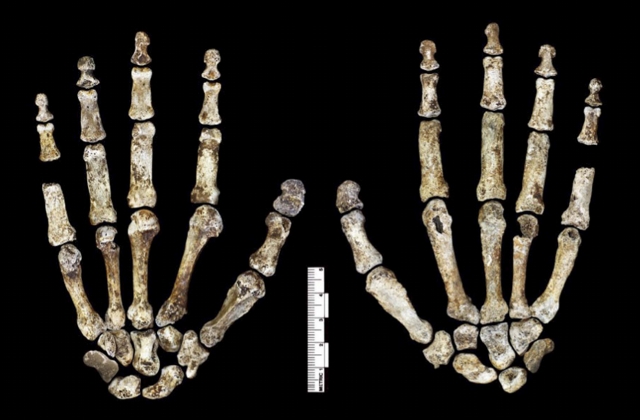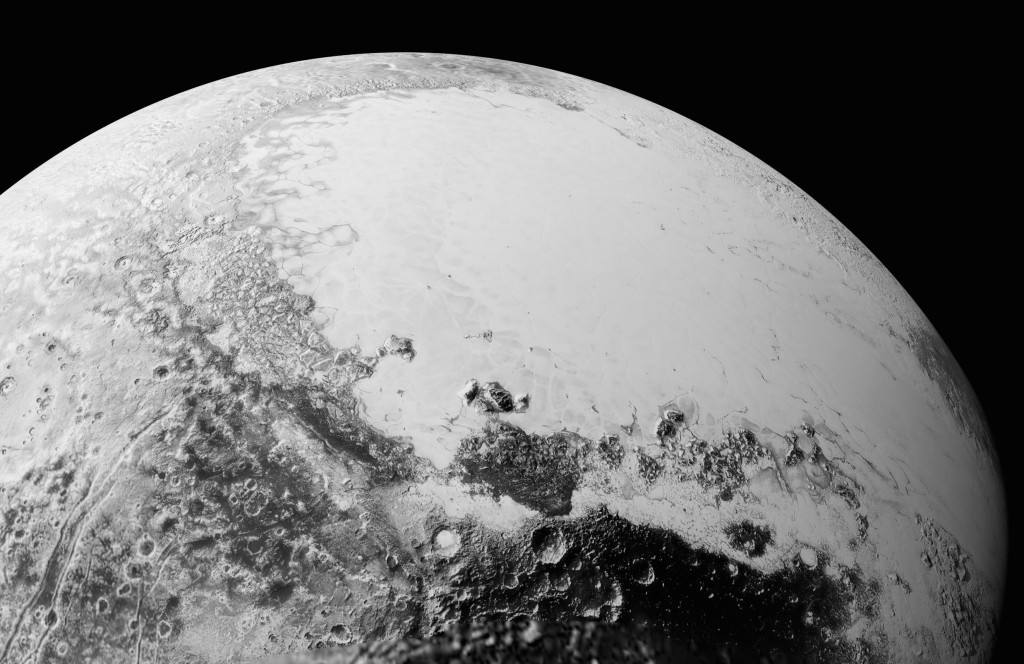
Homo Naledi
This week a new member of our extended family tree was revealed in an article in the journal eLIFE. An international team working in the Rising Star cave system in South Africa have collected and analyzed the contents of a cache of bones discovered by cavers. The find is notable for a few reasons: first, for the sheer number of bones. They estimate there are fifteen distinct individuals, making this one of the most complete records for a newly discovered hominid in recent memory. Second, for the skeletons themselves and what they tell us. H. naledi had curved bones in the hand, which typically indicates a lot of hanging from trees, but also a foot tuned to walking on the ground, with an arch like our own. Third, for the location of the bones. They were found in a chamber so deep in the cave system that a call had to go out for scientists who could fit through the 18cm-wide gap. Because of this, there are only bones of H. naledi in the chamber — none from any other creatures as one typically finds — suggesting that the bones were ritually deposited there. Unfortunately because of this last point, we’re having trouble dating them. Normally we rely on other inclusions in the deposits to make dating estimates, but in this case all that’s present is the bones themselves, so we’re going to have to be a bit more creative. For more info, check out the article over at eLIFE, or the BBC rundown.

Photos from Space
Three sets of astounding space images hit the net this week. First, as you can see above, the next set of beautiful hi-res images of Pluto popped up. Phil Plait has a great rundown of what you’re looking at over at Bad Astronomy, but if you want the raw images you can head over to the New Horizons gallery page. Speaking of Phil Plait, he also posted a great shot of a nearby (“nearby”) galaxy that’s just stunning. It comes from the Hubble, which is still cranking out amazing images and useful data after twenty five years. Lastly, there are some newer, closer images of Ceres (including the still weird, still hard to explain “bright spot”) that really require your viewership. Go look.
SpaceX News
In addition to an appearance on the brand new Late Show with Stephen Colbert, two more tidbits of news hit the airwaves this week. First, the announcement of the new schedule for the Falcon Heavy. The rocket, which will be the most powerful one in operation on Earth and the second most powerful rocket in history (after the moon-launch Saturn V), is now scheduled for its maiden flight in Spring of next year. SpaceX has faced delays in much of its schedule due in part to the loss of their ISS resupply mission earlier this year. The other piece of news is about a new photoset of the interior of the crew dragon, which you can see over at SpaceX. It’s… well let’s just say it’s nice. Very nice. Go look.
250 Megapixels
Canon has released its new camera sensor. It’s 250 megapixels. Now, I use an old eight megapixel (I think) bridge camera with a nice optical zoom. But once you’ve taken a shot with it, there’s still only so much zooming you can do digitally. I think it’s pretty safe to say that where we used to laugh at the moments on tv or in movies where they say “enhance” — well, I think those days are actually coming. Weird, right? According to Ars Technica, it can read the lettering on an airplane eleven miles up, and produces images that are 350 megs each. Maybe something to put on your U2 spy plane, then, rather than your point-and-shoot. For now.
Basques
According to a new study out this week in the Proceedings of the National Academy of Sciences (PNAS) journal, new genomic research has given us a window into one of the more perplexing populations in Europe. The Basques, who live in an area typically known as Basque Country, on the border between Spain and France, are a distinct ethnicity with an even more distinct language (Euskara is unrelated to pretty much any Indo-European language). The new study, “Ancient genomes link early farmers from Atapuerca in Spain to modern-day Basques,” shows that the skeletons of eight individuals from 5500-3500 years ago, found in El Portalón cave, Spain, bear the most similarity to modern-day Basques. The results suggest that the Basques are the descendants of early Iberian farmers who mixed with hunter-gatherers from the region before becoming a stable and geographically isolated population that resisted subsequent waves of conquest and settlement. Check out the BBC article, or the original paper for more.
In Case You Missed It
This week we started with a link to John Cook’s Five Characteristics of Science Denial; on Tuesday we took at look at the phrase “attributable to” and the claim that not getting a high-school diploma is as bad for you as smoking; on Wednesday I explained why the latest study linking acupuncture to lower blood pressure doesn’t tell us much of anything; on Thursday I posted another wonderful picture of the Vought Corsair; and on Friday, Lindsey brought to our attention a case study in why maybe you shouldn’t sexualize teenaged girls when they’re just trying to be a friggin rock band. If you haven’t seen those posts, check them out!
Best of the Rest
Other things happened this week, including:
- The US argued about whether or not data on foreign hard drives was under its jurisdiction
- People got excited about blobs of edible water
- The author of “The Immortal Life of Henrietta Lacks” had to defend herself against absurd charges of “pornography”
- Scientists announced they’d be reviving another giant virus from the permafrost, and
- Gizmodo linked to a downloadable PDF of NASA’s old style guide (check that out, it’s kind of amazing).
We’ll end today with a video of people trying to pronounce the chemicals in your food. Your natural, organic, fair-trade food.
Thanks for reading. Don’t forget to follow us on Twitter and like us on Facebook, and have a great week.

